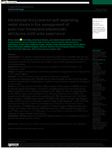Intraductal fully covered self-expanding metal stents in the management of post-liver transplant anastomotic strictures: a UK wide experience
| dc.contributor.author | Ahmed, W | |
| dc.contributor.author | Kyle, D | |
| dc.contributor.author | Khanna, A | |
| dc.contributor.author | Devlin, J | |
| dc.contributor.author | Reffitt, D | |
| dc.contributor.author | Zeino, Z | |
| dc.contributor.author | Webster, G | |
| dc.contributor.author | Phillpotts, S | |
| dc.contributor.author | Gordon, R | |
| dc.contributor.author | Corbett, G | |
| dc.contributor.author | Gelson, W | |
| dc.contributor.author | Nayar, M | |
| dc.contributor.author | Khan, H | |
| dc.contributor.author | Cramp, Matthew | |
| dc.contributor.author | Potts, J | |
| dc.contributor.author | Fateen, W | |
| dc.contributor.author | Miller, H | |
| dc.contributor.author | Paranandi, B | |
| dc.contributor.author | Huggett, M | |
| dc.contributor.author | Everett, SM | |
| dc.contributor.author | Hegade, VS | |
| dc.contributor.author | O’Kane, R | |
| dc.contributor.author | Scott, R | |
| dc.contributor.author | McDougall, N | |
| dc.contributor.author | Harrison, P | |
| dc.contributor.author | Joshi, D | |
| dc.date.accessioned | 2022-11-02T09:21:53Z | |
| dc.date.issued | 2022-01 | |
| dc.identifier.issn | 1756-283X | |
| dc.identifier.issn | 1756-2848 | |
| dc.identifier.uri | http://hdl.handle.net/10026.1/19816 | |
| dc.description.abstract |
<jats:sec><jats:title>Background:</jats:title><jats:p> Fully covered intraductal self-expanding metal stents (IDSEMS) have been well described in the management of post-liver transplant (LT) anastomotic strictures (ASs). Their antimigration waists and intraductal nature make them suited for deployment across the biliary anastomosis. </jats:p></jats:sec><jats:sec><jats:title>Objectives:</jats:title><jats:p> We conducted a multicentre study to analyse their use and efficacy in the management of AS. </jats:p></jats:sec><jats:sec><jats:title>Design:</jats:title><jats:p> This was a retrospective, multicentre observational study across nine tertiary centres in the United Kingdom. </jats:p></jats:sec><jats:sec><jats:title>Methods:</jats:title><jats:p> Consecutive patients who underwent endoscopic retrograde cholangiopancreatography with IDSEMS insertion were analysed retrospectively. Recorded variables included patient demographics, procedural characteristics, response to therapy and follow-up data. </jats:p></jats:sec><jats:sec><jats:title>Results:</jats:title><jats:p> In all, 162 patients (100 males, 62%) underwent 176 episodes of IDSEMS insertion for AS. Aetiology of liver disease in this cohort included hepatocellular carcinoma ( n = 35, 22%), followed by alcohol-related liver disease ( n = 29, 18%), non-alcoholic steatohepatitis ( n = 20, 12%), primary biliary cholangitis ( n = 15, 9%), acute liver failure ( n = 13, 8%), viral hepatitis ( n = 13, 8%) and autoimmune hepatitis ( n = 12, 7%). Early AS occurred in 25 (15%) cases, delayed in 32 (20%) cases and late in 95 (59%) cases. Age at transplant was 54 years (range, 12–74), and stent duration was 15 weeks (range, 3 days–78 weeks). In total, 131 (81%) had complete resolution of stricture at endoscopic re-evaluation. Stricture recurrence was observed in 13 (10%) cases, with a median of 19 weeks (range, 4–88 weeks) after stent removal. At removal, there were 21 (12%) adverse events, 5 (3%) episodes of cholangitis and 2 (1%) of pancreatitis. In 11 (6%) cases, the removal wires unravelled, and 3 (2%) stents migrated. All were removed endoscopically. </jats:p></jats:sec><jats:sec><jats:title>Conclusion:</jats:title><jats:p> IDSEMS appears to be safe and highly efficacious in the management of post-LT AS, with low rates of AS recurrence. </jats:p></jats:sec> | |
| dc.format.extent | 175628482211224-175628482211224 | |
| dc.format.medium | Electronic-eCollection | |
| dc.language | en | |
| dc.language.iso | eng | |
| dc.publisher | SAGE Publications | |
| dc.subject | biliary stricture | |
| dc.subject | ERCP | |
| dc.subject | intra-ductal fully covered metal stent | |
| dc.subject | liver transplant | |
| dc.title | Intraductal fully covered self-expanding metal stents in the management of post-liver transplant anastomotic strictures: a UK wide experience | |
| dc.type | journal-article | |
| dc.type | Journal Article | |
| plymouth.author-url | https://www.webofscience.com/api/gateway?GWVersion=2&SrcApp=PARTNER_APP&SrcAuth=LinksAMR&KeyUT=WOS:000861190000001&DestLinkType=FullRecord&DestApp=ALL_WOS&UsrCustomerID=11bb513d99f797142bcfeffcc58ea008 | |
| plymouth.volume | 15 | |
| plymouth.publication-status | Published | |
| plymouth.journal | Therapeutic Advances in Gastroenterology | |
| dc.identifier.doi | 10.1177/17562848221122473 | |
| plymouth.organisational-group | /Plymouth | |
| plymouth.organisational-group | /Plymouth/Faculty of Health | |
| plymouth.organisational-group | /Plymouth/Faculty of Health/Peninsula Medical School | |
| plymouth.organisational-group | /Plymouth/REF 2021 Researchers by UoA | |
| plymouth.organisational-group | /Plymouth/REF 2021 Researchers by UoA/UoA01 Clinical Medicine | |
| plymouth.organisational-group | /Plymouth/Research Groups | |
| plymouth.organisational-group | /Plymouth/Research Groups/Institute of Translational and Stratified Medicine (ITSMED) | |
| plymouth.organisational-group | /Plymouth/Research Groups/Institute of Translational and Stratified Medicine (ITSMED)/CBR | |
| plymouth.organisational-group | /Plymouth/Users by role | |
| plymouth.organisational-group | /Plymouth/Users by role/Academics | |
| dc.publisher.place | England | |
| dcterms.dateAccepted | 2022-07-24 | |
| dc.rights.embargodate | 2022-11-3 | |
| dc.identifier.eissn | 1756-2848 | |
| dc.rights.embargoperiod | Not known | |
| rioxxterms.versionofrecord | 10.1177/17562848221122473 | |
| rioxxterms.licenseref.uri | http://www.rioxx.net/licenses/all-rights-reserved | |
| rioxxterms.licenseref.startdate | 2022 | |
| rioxxterms.type | Journal Article/Review |


